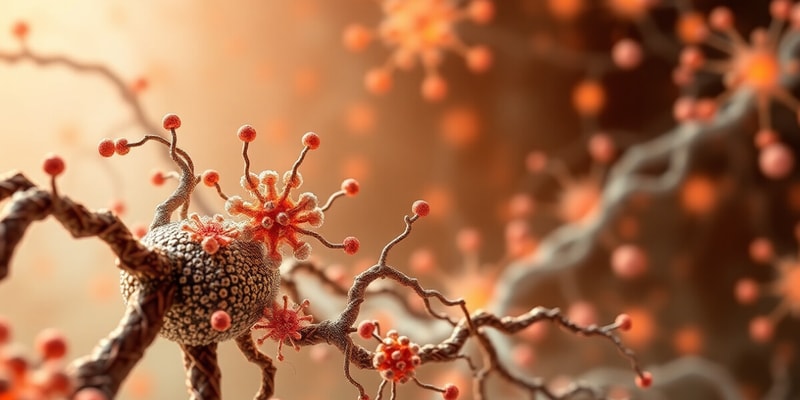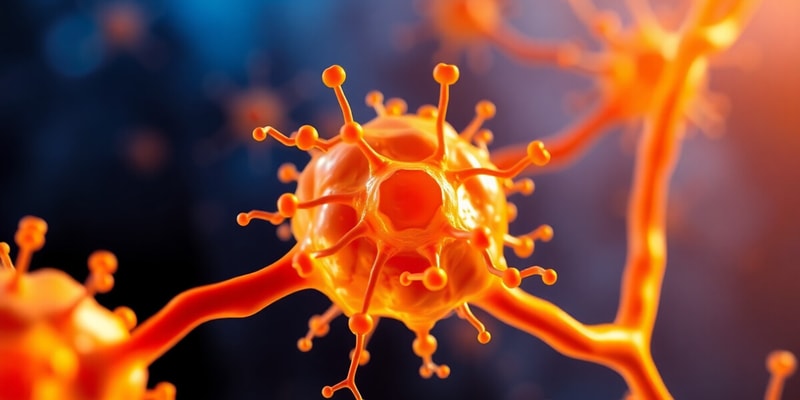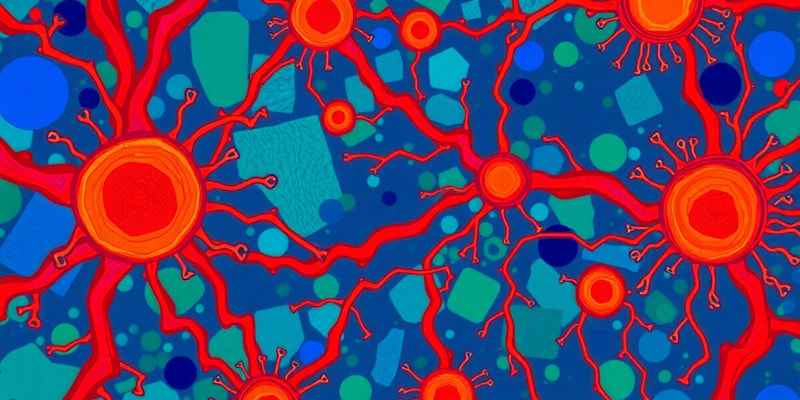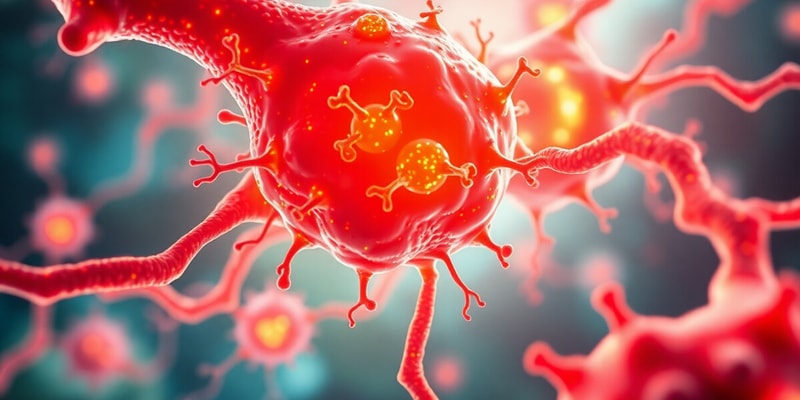Podcast Beta
Questions and Answers
What role does the synapse play in T cell activation?
Which statement accurately describes the phosphorylation process in T cell signaling?
Which transcription factors are crucial for T cell responses after antigen recognition?
What is one consequence of the degradation of signaling proteins in T cells?
Signup and view all the answers
What is the role of ITAMs in T cell signaling?
Signup and view all the answers
What is the primary role of non-receptor tyrosine kinases in cellular receptors?
Signup and view all the answers
Which characteristic is specific to receptor tyrosine kinases (RTKs)?
Signup and view all the answers
What differentiates nuclear receptors from other types of cellular receptors?
Signup and view all the answers
Which statement is true about inhibitory receptors in the immune system?
Signup and view all the answers
Which receptor is specifically mentioned as an inhibitory receptor found on T cells?
Signup and view all the answers
What structural feature is characteristic of the T cell receptor (TCR)?
Signup and view all the answers
In the context of T cell receptors, what forms the antigen-binding portion?
Signup and view all the answers
What role do ITAM motifs play in immune receptors?
Signup and view all the answers
What is the primary function of cell surface receptors in relation to extracellular molecules?
Signup and view all the answers
Which process is essential for the activation of signaling pathways initiated by cell surface receptors?
Signup and view all the answers
Which of the following statements about nuclear receptors is true?
Signup and view all the answers
What is a common early event in signal transduction involving receptors?
Signup and view all the answers
Which type of enzymes are responsible for adding phosphate groups onto amino acid side chains in cell signaling?
Signup and view all the answers
In signal transduction, which phase follows the initial cytosolic phase after receptor activation?
Signup and view all the answers
Which of the following is NOT a function of cell surface receptors?
Signup and view all the answers
What role does phosphorylation play in cell signaling?
Signup and view all the answers
Which type of receptor does not have intrinsic catalytic activity in its cytoplasmic tail?
Signup and view all the answers
What is the primary function of nuclear hormone receptors?
Signup and view all the answers
Which category of receptors involves the exchange of GDP with GTP for activation?
Signup and view all the answers
Which receptor type influences the development of the immune system and cytokine gene expression?
Signup and view all the answers
What role do receptors of the Notch family primarily serve?
Signup and view all the answers
Which receptors are known to be involved in mediating immune functions through specific ligands?
Signup and view all the answers
What process is triggered by the association of specific ligands with Notch family receptors?
Signup and view all the answers
Which statement correctly describes receptor tyrosine kinases (RTKs)?
Signup and view all the answers
What is the primary function of the hypervariable regions of the TCR?
Signup and view all the answers
Which of the following correctly describes the structure of CD4 molecules?
Signup and view all the answers
What distinguishes CD8 from CD4 in terms of T cell expression?
Signup and view all the answers
How does the immune synapse contribute to T cell signaling?
Signup and view all the answers
What is the composition of most CD8 molecules?
Signup and view all the answers
Which aspects of the TCR complex are directly involved in T cell activation?
Signup and view all the answers
Which regions of the MHC molecules do CD4 and CD8 co-receptors bind to?
Signup and view all the answers
What is the key role of the CDRs within TCR chains?
Signup and view all the answers
Study Notes
Cell Surface Receptors
- Cells have specific surface receptors that can be triggered by external ligands
- Receptors serve several key functions: induction of intracellular signaling, cell to cell adhesion, and cell internalization of molecules
- Signals are initiated by receptors, which typically involve an initial cytosolic phase
- Activation of transcription factors that are silent in resting cells (e.g. nuclear translocation, changes in gene expression)
Cell Surface Receptors and Signal Transduction
- Signal transduction is also known as intracellular signaling pathways
- Receptors are present on the plasma membrane; their extracellular domains recognize soluble ligands or structures
- Nuclear receptors are found intracellularly
Addition/Removal of Phosphate
- A common early event in signal transduction is the addition of a phosphate residue to the cytosolic portion of a receptor
- Protein kinases are enzymes that add phosphate groups onto amino acid side chains
Categories of Cellular Receptors
- Non-receptor tyrosine kinases: cytoplasmic tails have no catalytic activity, but a separate intracellular tyrosine kinase participates in receptor activation
- Receptor tyrosine kinases (RTKs): integral membrane proteins that activate an intrinsic tyrosine kinase domain
- Nuclear receptors: typically located in the nucleus and function as transcription factors; they influence events, including development of the immune system
- G protein–coupled receptors (GPCRs): receptors that activate associated GTP-binding proteins
- Receptor proteins of the Notch family: involved in development and contribute to cell fate determination
Immune Receptor Family
- Immune receptors that activate immune cells have separate polypeptide chains and associated polypeptide chains that contain cytosolic Immunoreceptor tyrosine-based activation motifs (ITAMs)
- The B cell receptor (BCR), the T cell receptor (TCR), and the high-affinity receptor for IgE (FcεRI) all have ITAMs motifs
- Inhibitory receptors in the immune system typically have ITIM motifs on the cytosolic portion
- FcγRIIB is an inhibitory receptor found on B cells and myeloid cells
T Cell Receptor for Antigen
- The antigen receptor of MHC-restricted CD4+ helper T cells and CD8+ cytotoxic T lymphocytes (CTLs) is a heterodimer
- The antigen-binding portion of the TCR is formed by the Vβ and Vα domains
Binding of TCR to an MHC molecule
- The V regions of the TCR α and β chains contain short stretches of amino acids that form the hyper-variable or complementarity-determining regions (CDRs)
- Three CDRs in the α chain and three in the β chain form the part of the TCR that specifically recognizes peptide-MHC complexes
TCR Component
- CD4 and CD8 are T cell coreceptors that bind to nonpolymorphic regions of MHC molecules
- Mature αβ T cells express either CD4 or CD8, but not both
Role of the CD4 and CD8 Coreceptors in T Cell Activation
- CD4 has four extracellular Ig-like domains, a hydrophobic transmembrane region, and a cytoplasmic tail
- The two N-terminal Ig-like domains of the CD4 protein bind to the nonpolymorphic α2 and β2 domains of the class II MHC molecule
- Most CD8 molecules exist as disulfide-linked heterodimers composed of two chains called CD8α and CD8β
- Both the CD8 α chain and the β chain have a single extracellular Ig domain, a hydrophobic transmembrane region, and a cytoplasmic tail
The Immune Synapse
- The synapse forms a stable contact between an antigen-specific T cell and an APC displaying that antigen
- The immune synapse provides a unique interface for TCR triggering
- The synapse ensures the specific delivery of secretory granule contents and cytokines from a T cell to APCs or to targets in contact with the T cell
Signal Transduction
- Phosphorylation of proteins and lipids plays a central role in the transduction of signals from the TCR complex and coreceptors
- Lck phosphorylates the ITAMs of the CD3 and ζ chains
Activation of Transcription Factors That Regulate T Cell Gene Expression
- Different transcription factors are activated by different cytoplasmic signal transduction pathways
- Three transcription factors activated in T cells by antigen recognition are nuclear factor of activated T cells (NFAT), AP-1, and NF-κB
Studying That Suits You
Use AI to generate personalized quizzes and flashcards to suit your learning preferences.
Related Documents
Description
This quiz explores the functions and mechanisms of cell surface receptors in signal transduction. It covers the roles of receptors in cellular signaling, adhesion, and internalization of molecules. Additionally, the quiz delves into the biochemical processes, such as phosphorylation, involved in these pathways.




